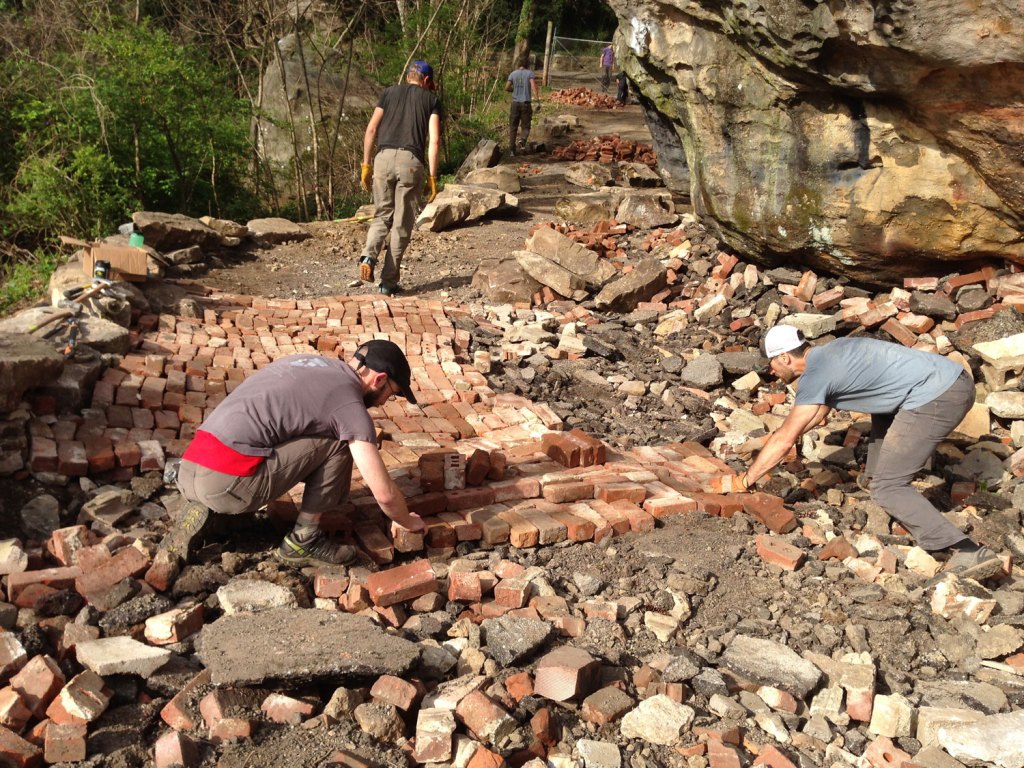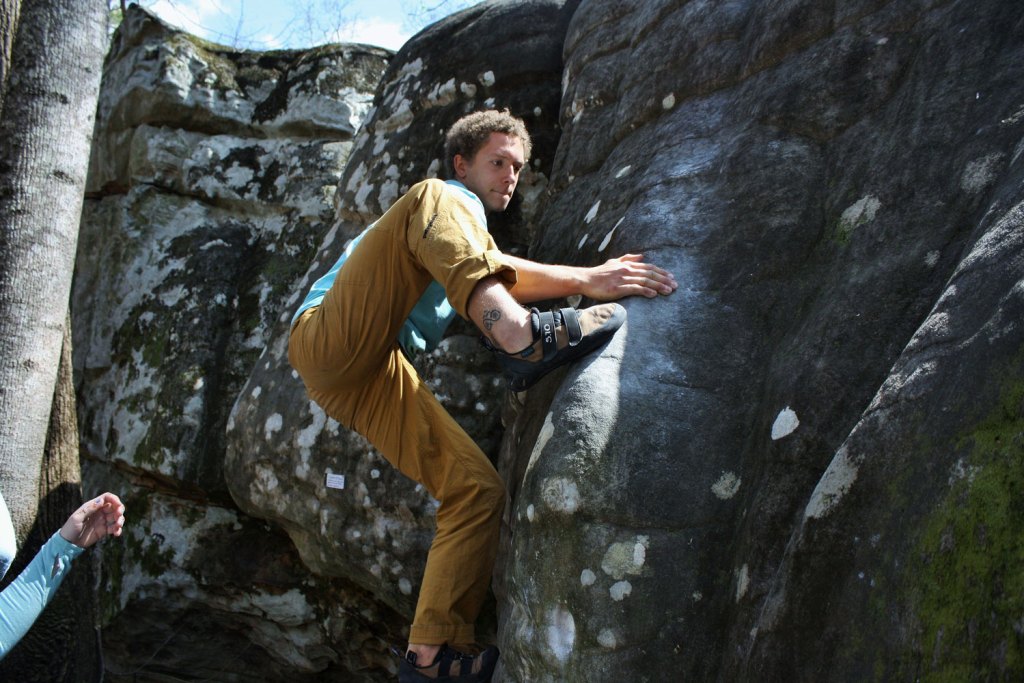Atlanta is one of the fastest growing metro areas in the nation—behind only Dallas and Houston—and as its population continues to grow, so does the demand for development. However, the Southeast region of the United States is also known for its world-class climbing, and as the demand for development increases, so does the threat to local climbing areas.
But thanks to organizations like the Southeastern Climbers Coalition (SCC), people living in these rapidly growing urban areas can continue to climb. Based in Chattanooga, Tennessee, the SCC works to create and maintain access to climbing areas across three states—Tennessee, Alabama and Georgia—all with just one full-time employee, a board of eight and a community of dedicated volunteers who share a passion for climbing. The Southeast region is unique in that there are fewer public lands and wild spaces where people can recreate than other regions of the country, and many climbing areas are held by private landowners.

Volunteers remove graffiti from a climbing area. REI funds have helped to remove more than 1,000 square feet of graffiti at Boat Rock and Curahee Mountain in GA. (Photo Credit: SCC)
REI has partnered with the SCC for the past 15 years, providing funds for a variety of projects including support for the SCC’s volunteer trail days and the removal of more than 1,000 square feet of graffiti and valuable trail work at Boat Rock and Currahee Mountain in Georgia to protect against trail erosion. These projects help ensure that climbing routes are safe, accessible and sustainable for the future. This year, REI is providing $28,000 in grants to support the SCC’s efforts. REI funds are being used to build a new, safer parking lot for climbers at Boat Rock in Atlanta, construct stairs and belay structures at Denny Cove in eastern Tennessee, and add more than a mile of trail at Hell’s Kitchen, just north of Chattanooga, Tennessee.
We caught up with SCC Executive Director Cody Roney to learn about the work that the SCC and its volunteers do to promote access to climbing areas across the Southeast.
Can you give us an overview of your organization?
Our mission is to protect climbing areas for future generations. A big part of that is purchasing areas that are under threat and working with state, local and private landowners to open climbing on their land. Our organization covers 30 climbing areas in the TAG region (Tennessee, Alabama, Georgia), from areas with only a handful of routes to world-class climbing destinations. Most climbing areas are within about a two-hour drive from major population areas, but usually they are closer. Most people in our region can get to these areas easily. We have made nine climbing area and access purchases, owning most in perpetuity, and transferring one [Denny Cove] to the state of Tennessee to manage as a new park within the South Cumberland State Park system. We also hold three leases on private land. When we purchase or lease an area, we never close it, charge to use it or sell it for any use other than recreation.
You mentioned part of this work is purchasing land under threat. How does this work?
The South is unique in that almost 80 percent of our climbing areas are located on private property, so we have to work with private landowners or buy these properties to prevent them from being developed. It’s a little bit different from other parts of the country where much of the land is public and managed by state or federal partners.
We have made nine climbing-area purchases, and we’ve transferred one to the state of Tennessee. Any area we buy, we keep it open to the public for free. When we transfer land to the state, we include stipulations that they can’t close the area to climbing. The SCC continues to help manage the climbing, but the state owns and manages the entirety of the park and can add trails, infrastructure and other outdoor recreational activities.

Volunteers lay trail to provide access to climbing areas. The SCC hosts trails days throughout the year when volunteers can work together to create better access to local climbing areas. (Photo Credit: SCC)
I imagine working with so many different types of landowners can be a challenge. What are some of the efforts that go on behind-the-scenes to keep these climbing areas open?
Sometimes it takes years to build the relationship with landowners, and that’s just to start talking to someone about opening land to climbing. … Some landowners are open to climbing, some aren’t. Opening privately owned climbing areas can be particularly difficult with our cliff-line areas where one person owns the bluff-view property on top, and another owns the bottom. The person with the bluff-view property may not want people climbing below them, but the person who owns the bottom is willing to work with you. There are unique solutions to issues like this, including working out an agreement or lease situation with one of the landowners, purchasing part or all of the cliff or sometimes just giving it more time to further develop those relationships in hopes of a future access win.
When it comes to state land, sometimes politics come into play. Positions on climbing can change based on who is in office, but over the years, climbers have built a solid relationship with the park system. In Tennessee, climbers are one of the largest user-groups of state parks. In 2016, we worked with the state of Tennessee to add climbing to the state management plan, making our relationship with the state more formal. This effort was nearly 20 years in the making. Climbing is such a different type of sport, and for people who don’t do it, it’s confusing. We worked with the state on adding climber language and input, advising on things like what are climbers responsible for, what does climber rescue look like if someone gets injured.
Can you give us some examples of the areas you work in?
Boat Rock in Atlanta was the first acquisition project for the SCC. Climbers have been going out there since the early 1980s, and in the late 1990s, a developer bought the property and started blowing up sections of the rock to build housing developments. The SCC was very grassroots at that time, so a group of local climbers in Atlanta got together and contacted the developer. Eventually, he agreed to sell a piece of it to the SCC, so we got together and purchased the area. Now there’s a boulder field in the middle of this housing development. There were acres and acres that were lost, but we got to protect some of it.
A more recent example is in 2012, the Hospital Boulders in Alabama, which could have seen a similar fate. This was a well-known climbing area for years and the previous owners were not climber-friendly. We approached them many times to purchase the land, but it eventually went to an auction twice and the SCC was able to acquire it after almost losing it in the first auction. This area sits at the end of a neighborhood—and could have been lost to development if the SCC hadn’t purchased it.
What’s new for 2018 and how is the SCC gearing up for the future?
REI has been our most integral partner in our efforts over the years. This year, we’ve been able to hire a part-time, grant-funded stewardship director who is a professional trail builder. She will help make sure our properties are well taken care of and that our trails are built in a sustainable way. Our hope is that in the next five years, she can become a full-time member of our staff. We are very hopeful that our stewardship program is going to take off.
We’re also working with local high school and climbing gym teams, helping to build the next generation of climbers. This year marked our 25th anniversary, and we know that in order to successfully pass the torch, we have to mentor and bring in the next generation. We’re working with all youth in various capacities—climbing inside and out—to inspire the next generation of climbers.
How can people get involved with the SCC?
We rely heavily on volunteers. The best way to get involved is to come to one of our Trail Days, where we work to build sustainable trails. It’s hard work, but it’s valuable work with very tangible results. Plus, we usually go climbing together afterwards. It’s a great way to meet other people who are new to climbing. We have several Trails Days throughout the year all around the TAG region.

The SCC’s trails days allow local climbers to connect and climb together, while stewarding the areas in which they climb. (Photo Credit: SCC)
Most large nonprofits have a full staff, and we have none of that. It’s great to have volunteers with specialized expertise. For example, we have people that call and say they’re a lawyer and can provide some pro bono work. We have people who are accountants who help us keep our finances in order. We have volunteers with web design experience to help with our webpage and social media. We also often rely on volunteer photographers. Without these amazing volunteers we probably wouldn’t be where we are today!
REI has partnered with the SCC since 2003 and has awarded the nonprofit with $75,450 to date. To volunteer with the SCC, visist secclimb.org.


